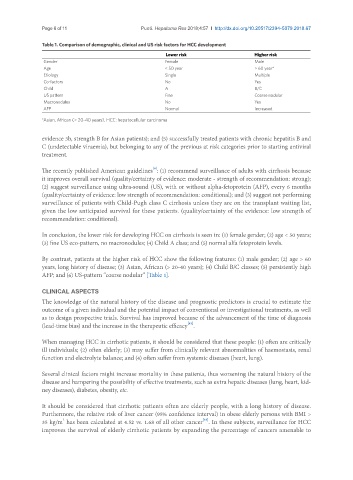Page 616 - Read Online
P. 616
Page 6 of 11 Puoti. Hepatoma Res 2018;4:57 I http://dx.doi.org/10.20517/2394-5079.2018.67
Table 1. Comparison of demographic, clinical and US risk factors for HCC development
Lower risk Higher risk
Gender Female Male
Age < 50 year > 60 year*
Etiology Single Multiple
Co-factors No Yes
Child A B/C
US pattern Fine Coarse nodular
Macronodules No Yes
AFP Normal Increased
*Asian, African (> 20-40 years). HCC: hepatocellular carcinoma
evidence 3b, strength B for Asian patients); and (5) successfully treated patients with chronic hepatitis B and
C (undetectable viraemia), but belonging to any of the previous at risk categories prior to starting antiviral
treatment.
[8]
The recently published American guidelines : (1) recommend surveillance of adults with cirrhosis because
it improves overall survival (quality/certainty of evidence: moderate - strength of recommendation: strong);
(2) suggest surveillance using ultra-sound (US), with or without alpha-fetoprotein (AFP), every 6 months
(quality/certainty of evidence: low strength of recommendation: conditional); and (3) suggest not performing
surveillance of patients with Child-Pugh class C cirrhosis unless they are on the transplant waiting list,
given the low anticipated survival for these patients. (quality/certainty of the evidence: low strength of
recommendation: conditional).
In conclusion, the lower risk for developing HCC on cirrhosis is seen in: (1) female gender; (2) age < 50 years;
(3) fine US eco-pattern, no macronodules; (4) Child A class; and (5) normal alfa fetoprotein levels.
By contrast, patients at the higher risk of HCC show the following features: (1) male gender; (2) age > 60
years, long history of disease; (3) Asian, African (> 20-40 years); (4) Child B/C classes; (5) persistently high
AFP; and (6) US-pattern “coarse nodular” [Table 1].
CLINICAL ASPECTS
The knowledge of the natural history of the disease and prognostic predictors is crucial to estimate the
outcome of a given individual and the potential impact of conventional or investigational treatments, as well
as to design prospective trials. Survival has improved because of the advancement of the time of diagnosis
[45]
(lead-time bias) and the increase in the therapeutic efficacy .
When managing HCC in cirrhotic patients, it should be considered that these people: (1) often are critically
ill individuals; (2) often elderly; (3) may suffer from clinically relevant abnormalities of haemostasis, renal
function and electrolyte balance; and (4) often suffer from systemic diseases (heart, lung).
Several clinical factors might increase mortality in these patients, thus worsening the natural history of the
disease and hampering the possibility of effective treatments, such as extra hepatic diseases (lung, heart, kid-
ney diseases), diabetes, obesity, etc.
It should be considered that cirrhotic patients often are elderly people, with a long history of disease.
Furthermore, the relative risk of liver cancer (95% confidence interval) in obese elderly persons with BMI >
[46]
2
35 kg/m has been calculated at 4.52 vs. 1.68 of all other cancer . In these subjects, surveillance for HCC
improves the survival of elderly cirrhotic patients by expanding the percentage of cancers amenable to

